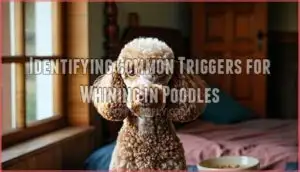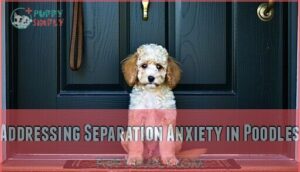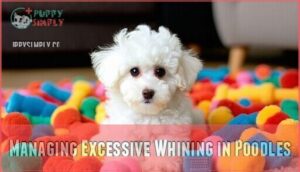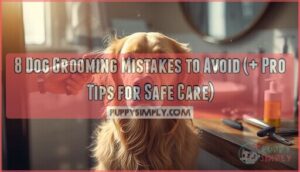This site is supported by our readers. We may earn a commission, at no cost to you, if you purchase through links.
 You’ll hear your poodle cry because they’re fundamentally having a conversation with you—those high-pitched whines and soft whimpers are their refined way of communicating needs, emotions, and physical states.
You’ll hear your poodle cry because they’re fundamentally having a conversation with you—those high-pitched whines and soft whimpers are their refined way of communicating needs, emotions, and physical states.
These sounds span everything from simple needs—hunger, potty breaks—to complex emotions like separation anxiety, which hits roughly half of all standard poodles.
Changes in their environment, bids for your attention, or physical discomfort from issues like sore joints can all spark these vocal appeals.
Think of it as your poodle’s emotional language—they’re not just making noise, they’re sharing their world with you. Understanding these vocal patterns helps you respond appropriately and strengthens your bond.
Table Of Contents
- Key Takeaways
- Understanding Poodle Vocalization
- Identifying Common Triggers for Whining in Poodles
- Addressing Separation Anxiety in Poodles
- Managing Excessive Whining in Poodles
- Strategies for Calming a Whining Poodle
- Preventing Tear Stains in Poodles
- Seeking Professional Help for Chronic Whining
- Creating a Bond With Your Whining Poodle
- Frequently Asked Questions (FAQs)
- Why do Poodles Cry?
- Why does my puppy Cry a lot?
- How do you know if a poodle is whining?
- Do poodles have separation anxiety?
- How do you get a poodle to stop whining?
- Why is my poodle begging for attention?
- Do poodles cry more than other dog breeds?
- Can medical conditions cause excessive poodle crying?
- At what age do poodles start crying?
- Are male or female poodles more vocal?
- Conclusion
Key Takeaways
- Your poodle’s crying is sophisticated communication – those high-pitched whines and soft whimpers aren’t just noise; they’re your dog’s way of expressing specific needs, emotions, and physical discomfort that require your attention and understanding.
- Separation anxiety affects about 50% of poodles – their deep emotional bond with you creates significant distress when you’re away, triggering excessive vocalizations that can be managed through gradual desensitization and independence training.
- Environmental triggers and attention-seeking drive most whining episodes – about 41% of poodle vocalizations stem from learned attention-seeking behaviors, while routine changes and anxiety triggers account for additional episodes that you can address through consistent training.
- Professional help becomes necessary for chronic cases – when home remedies aren’t working, veterinary behaviorists and certified trainers can identify underlying medical conditions like Addison’s disease or develop tailored treatment plans combining medication and behavior modification.
Understanding Poodle Vocalization
Your poodle’s sounds aren’t just noise—they’re actually a sophisticated way of telling you exactly what’s going on with them, whether that’s a specific need, how they’re feeling, or something happening with their body.
Here’s the thing about those sounds: crying means your poodle is genuinely distressed and needs help right now, while whining is more like them trying to have a conversation with you about something they want or need.
Communication Through Whining
Whining is your poodle’s go-to way of talking to you. These smart dogs have developed a whole vocabulary of sounds to get their point across – from the hungry whimper at dinner time to the anxious whine when they need to go out.
Pay attention to the different tones and pitches. Your poodle isn’t just making noise – they’re having a conversation with you about what they need or how they’re feeling.
Separation Anxiety
Your poodle’s separation anxiety stems from their deep emotional bond with you, creating significant separation stress when you’re away. This anxiety triggers excessive whining as they experience dog loneliness and emotional distress during owner absence.
Addressing poodle vocalizations requires patience and understanding of their underlying anxiety.
- Gradually increase departure time to reduce anxiety triggers
- Provide puzzle toys to combat attention-seeking behaviors
- Use calming pheromone diffusers for comfort
- Practice independence training consistently
Identifying Common Triggers for Whining in Poodles
Understanding what triggers your poodle’s whining helps you address the behavior effectively. Anxiety triggers affect approximately 50% of standard poodles, particularly during thunderstorms or fireworks. Environmental factors like routine changes cause whining in 22% of cases, while attention-seeking behaviors account for 41% of vocalization episodes. Recognizing canine communication patterns, including dog whining behaviors, is essential for identifying the underlying causes of whining.
| Category | Common Triggers | Frequency |
|---|---|---|
| Anxiety | Loud noises, storms, unfamiliar visitors | 24-50% |
| Physical Needs | Hunger, thirst, bathroom breaks | 17-20% |
| Pain Signals | Joint pain, digestive issues, injury | 8-15% |
Some poodles deal with health issues that make them more vocal. Addison’s disease hits about 8-10% of the breed and can trigger excessive whining during rough patches.
These dogs also struggle emotionally when left alone – their social nature makes separation tough. Without enough mental stimulation, boredom-related whining jumps by 18%.
When poodles get scared, they don’t just whine – about 13% will also try to hide during stressful situations.
Addressing Separation Anxiety in Poodles
Poodles develop separation anxiety for several interconnected reasons: they’re wired for attachment, sensitive to changes in routine, and often haven’t learned that being alone is okay.
When their favorite person leaves, these dogs might bark non-stop, chew furniture, or show physical signs of stress like panting and pacing.
The key to helping your poodle handle alone time? Start small and build up slowly. Try leaving for just 30 seconds at first, then gradually work up to longer periods as your dog stays calm.
Keep your departure routine low-key—no dramatic goodbyes that spike their anxiety before you even walk out the door.
Calming techniques include providing puzzle toys filled with high-value treats, creating safe spaces with familiar scents, and maintaining neutral energy during exits. Separation strategies should incorporate counter-conditioning exercises where your absence becomes associated with positive experiences rather than abandonment fears.
Emotional assistance doesn’t mean constant reassurance, which reinforces attention-seeking behaviors. Instead, reward quiet, independent behavior and ignore whining episodes. Professional behavioral assessments may recommend anti-anxiety medications for severe cases, though environmental modifications usually prove sufficient for most poodles experiencing mild to moderate separation anxiety symptoms.
Managing Excessive Whining in Poodles
When faced with persistent poodle vocalizations, you’re dealing with more than just noise—you’re addressing complex canine emotions and attention-seeking behaviors. Effective poodle training requires identifying specific triggers behind whining solutions. Teaching your dog a "quiet" cue helps interrupt excessive barking episodes.
Downplay greetings, keeping them short and simple to reduce excitement-based whining. Managing excessive whining in poodles involves consistent responses during puppy socialization phases. Address anxiety through structured mental stimulation rather than reinforcing attention-seeking patterns.
Professional behavioral assessment ensures lasting whining solutions. Understanding dog behavior through excessive barking issues is vital for effective training.
Strategies for Calming a Whining Poodle
Got a whining poodle on your hands? Quick behavioral fixes can stop the noise in just minutes.
You’ll get the best results by pairing distraction methods with calming aids – this approach hits both the immediate whining and the anxiety that’s driving it.
Distraction Techniques
Redirection methods offer effective behavioral intervention when your poodle starts crying or exhibiting attention-seeking behaviors. These sensory stimulation techniques interrupt the vocalization cycle while addressing underlying anxiety through positive engagement.
- Interactive puzzle toys – Hide treats inside feeding puzzles to redirect focus from whining to problem-solving activities.
- Environmental changes – Move your poodle to a different room or introduce new scents to shift their attention naturally.
- Playful interruptions – Initiate gentle training commands or brief play sessions using their favorite toys as calming signals.
This approach prevents reinforcement of crying while fulfilling your poodle’s need for mental stimulation and connection.
Calming Treats and Tools
Beyond distraction techniques, specialized calming aids can markedly reduce your poodle’s anxiety and vocalizations. Anti-anxiety chews containing L-theanine help decrease emotional distress, while soothing toys provide comfort during separation anxiety episodes. Aromatherapy diffusers and relaxing music create peaceful environments that minimize poodle vocalizations.
| Calming Aid Type | Primary Benefit | Best Used For |
|---|---|---|
| Anti-anxiety chews | Reduces stress hormones | Separation anxiety episodes |
| Aromatherapy diffusers | Creates calming environment | General anxiety management |
| Soothing comfort toys | Provides emotional security | Nighttime distress |
Preventing Tear Stains in Poodles
While calming strategies help reduce whining, addressing the physical manifestations of stress is equally important. Tear stains in Poodles often result from excessive crying and emotional distress, making proper Eye Care Tips a cornerstone of thorough poodle care.
Poodles develop tear stains when porphyrin-rich tears accumulate around their eyes, creating those telltale reddish-brown marks. Their shallow eye sockets and dense Facial Hair Management needs make them particularly susceptible to this issue.
Daily Poodle Grooming prevents stain buildup through consistent care:
- Wipe your poodle’s face twice daily with a damp cloth to remove tear residue before stains set
- Keep hair around the eyes trimmed short to reduce moisture retention and bacterial growth
- Switch to stainless steel bowls instead of plastic to minimize facial irritation
Dietary modifications greatly impact Tear Stain Removal success. High-iron foods increase porphyrin production, while grain-based diets can trigger allergic reactions that worsen tearing. Filtered water reduces mineral content that contributes to staining intensity.
Regular Skin Fold Cleaning prevents yeast proliferation in facial creases, addressing both hygiene and comfort concerns that may contribute to your poodle’s overall stress levels.
Seeking Professional Help for Chronic Whining
Sometimes your poodle’s whining crosses the line from occasional communication into chronic distress. When home remedies aren’t cutting it, getting professional help becomes your next move.
Nonstop crying and whining in poodles usually means something deeper is going on—either a health problem or behavioral issue that needs expert eyes. Getting help for excessive crying typically means working with both medical and behavioral specialists.
| Professional Type | Specialization | Treatment Focus |
|---|---|---|
| Veterinary Behaviorist | Medical + Behavioral | Separation Anxiety, medication |
| Certified Dog Trainer | Behavior Modification | Training protocols, conditioning |
| Veterinarian | Medical Assessment | Health screening, pain management |
| Canine Counseling Specialist | Anxiety in dogs | Stress reduction techniques |
| Animal Psychologist | Complex behaviors | Thorough behavior plans |
These professionals can identify whether your poodle’s vocalizations stem from medical conditions, anxiety, or learned behaviors. They’ll develop tailored treatment plans that might include anti-anxiety medications, structured training programs, or environmental modifications. Don’t wait until whining becomes your household soundtrack—early intervention prevents escalation.
Creating a Bond With Your Whining Poodle
While professional intervention helps address chronic whining, strengthening your emotional connection with your Poodle creates lasting behavioral improvements. Poodle socialization requires intentional bonding techniques that address their intelligent, attention-seeking nature. When you understand your Poodle’s need for canine empathy, you’ll transform anxiety-driven whining into productive communication.
Effective whine reduction starts with consistent daily interactions that build trust. Your Poodle’s vocalizations often signal a desire for deeper connection rather than simple attention-seeking behavior. Through patient bonding techniques, you’ll channel their emotional intelligence constructively.
- Schedule 15-minute focused training sessions using positive reinforcement to redirect whining into desired behaviors
- Create predictable routines that satisfy your Poodle’s need for security and reduce anxiety-based vocalizations
- Establish calm greeting rituals that acknowledge your Poodle without reinforcing excessive vocal demands
Remember, Poodles thrive on meaningful engagement. Your consistent presence and understanding responses teach them appropriate communication methods, replacing problematic whining with healthier interaction patterns.
Frequently Asked Questions (FAQs)
Why do Poodles Cry?
Picture your poodle’s tearful eyes reflecting pure vulnerability. You’ll notice they cry from anxiety, pain, attention-seeking, or basic needs like hunger.
Their vocalizations communicate distress, fear, or simply wanting your comfort and connection.
Why does my puppy Cry a lot?
Your puppy’s excessive crying likely stems from basic needs like hunger, bathroom breaks, or discomfort.
Separation anxiety, attention-seeking behavior, or adjusting to new environments can also trigger frequent vocalizations in young poodles.
How do you know if a poodle is whining?
You’ll recognize poodle whining by its softer, continuous sound compared to sharp crying. Watch for body language like pacing, pawing, or restless behavior accompanying the vocalization.
Do poodles have separation anxiety?
Yes, poodles are particularly prone to separation anxiety due to their intelligent, social nature. They form strong bonds with owners and can become distressed when left alone, leading to crying, whining, and destructive behaviors.
How do you get a poodle to stop whining?
Stop whining by identifying the cause first. Address basic needs like hunger or bathroom breaks.
Use positive reinforcement when they’re quiet, ignore attention-seeking whines, and provide mental stimulation to prevent boredom.
Why is my poodle begging for attention?
Your poodle’s begging stems from their intelligence and social nature. They’ve learned that attention-seeking behaviors work effectively.
Poodles crave mental stimulation and interaction, making persistent requests when they feel understimulated or disconnected from you.
Do poodles cry more than other dog breeds?
Like a parent eavesdropping on phone conversations, Miniature Dachshunds and Toy Poodles were less fearful compared to other breeds, suggesting they’re actually quieter than many dogs.
Your poodle’s tendency to cry isn’t breed-specific—it’s about communication, not excessive vocalization.
Can medical conditions cause excessive poodle crying?
Medical conditions can definitely trigger excessive crying in your poodle. Addison’s disease, which affects 8-10% of poodles, can cause vocalization during flare-ups.
Gastrointestinal issues, chronic pain, and hormonal imbalances also increase crying behaviors considerably.
At what age do poodles start crying?
Puppies generally begin vocalizing within their first few weeks of life. You’ll notice your poodle puppy starts crying around 2-3 weeks old, coinciding with their eye and ear development.
Are male or female poodles more vocal?
Studies reveal male poodles tend to be slightly more vocal than females.
You’ll find males are naturally attention-seeking and communicate more frequently with their owners, while females are generally quieter and more independent.
Conclusion
Ironically, understanding why poodles cry often stops the behavior faster than ignoring it. Your poodle’s whining functions as detailed communication.
Addressing underlying causes like separation anxiety, medical discomfort, or attention-seeking patterns creates lasting solutions. Through consistent training, environmental modifications, and professional guidance when needed, you’ll transform those vocal conversations into peaceful coexistence.
Remember, each whine carries meaning, and responding appropriately strengthens your bond while reducing excessive vocalization.
- https://www.nature.com/articles/d41586-022-02280-z
- https://www.nytimes.com/2022/08/22/science/dogs-crying-tears.html
- https://dogbehavior.it/dogbehavior/article/download/105/72/471
- https://mywaggle.com/blogs/pet-protection/understanding-the-origins-of-separation-anxiety-in-poodles
- https://www.petplay.com/blogs/tips/5-most-common-poodle-health-issues













